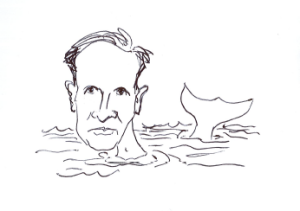Philip Hoare’s The Sea Inside is a mighty fine piece of sustained observation, as nature writing should be. Unlike, say, a David Attenborough documentary, it is also a personal one. He is something of a lost soul, cruising the world for sightings of whales and birds. There is something appropriate about his loitering in the liminal spaces, gazing after half-glimpsed creatures. He hints at darkness in his past and comments that home doesn’t really exist. Nature writing often tends, perhaps against expectations, to be more personal than cold scientific observation, and whether it be Ronald Blythe or his predecessor Francis Kilvert, or Iain Sinclair (who is a sort-of suburban nature-writer) or the recent wonder The Old Ways, from Robert Macfarlane, nature writing, as it describes the outside world, can often have things to say, perhaps inadvertently, about the inner one, as perhaps Hoare’s title hints at. Following on from his book about Moby Dick (another book that purports to be about the “outer” world of whaling but is as much about the inner world), Hoare observes the sea and its inhabitants and fringe-dwellers in the southern part of England before venturing wider to Tasmania and New Zealand, in search of, or in lament of, the thylacine and the moa. Along the way he mentions the desert fathers, Thomas Merton, and the preposterously good looking (female) whaling captain Valentina Orlikova, who even featured on the cover of Harpers Bazaar. And like the aforementioned Macfarlane, Hoare gives us a reversal of the usual map of the world, which places the oceans as blank frames for the land. Hoare quotes Arthur C Clarke, who said that our planet should more realistically be called ‘The Ocean’. Writers are often thought of as hunched over a desk, and far from outdoorsy, but Hoare and Macfarlane dispel that image for a more Hemingwayesque one, with their icy swimming, rough sleeping, and early morning rises.
Loitering in the liminal
Reply

